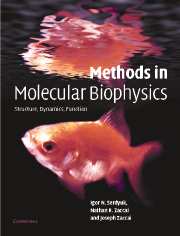Book contents
- Frontmatter
- Contents
- Foreword by D. M. Engelman
- Foreword by Pierre Joliot
- Preface
- Introduction: Molecular biophysics at the beginning of the twenty-first century: from ensemble measurements to single-molecule detection
- Part A Biological macromolecules and physical tools
- Part B Mass spectrometry
- Part C Thermodynamics
- Part D Hydrodynamics
- Part E Optical spectroscopy
- Part F Optical microscopy
- Chapter F1 Light microscopy
- Chapter F2 Atomic force microscopy
- Chapter F3 Fluorescence microscopy
- Chapter F4 Single-molecule detection
- Chapter F5 Single-molecule manipulation
- Part G X-ray and neutron diffraction
- Part H Electron diffraction
- Part I Molecular dynamics
- Part J Nuclear magnetic resonance
- References
- Index of eminent scientists
- Subject Index
- References
Chapter F4 - Single-molecule detection
from Part F - Optical microscopy
Published online by Cambridge University Press: 05 November 2012
- Frontmatter
- Contents
- Foreword by D. M. Engelman
- Foreword by Pierre Joliot
- Preface
- Introduction: Molecular biophysics at the beginning of the twenty-first century: from ensemble measurements to single-molecule detection
- Part A Biological macromolecules and physical tools
- Part B Mass spectrometry
- Part C Thermodynamics
- Part D Hydrodynamics
- Part E Optical spectroscopy
- Part F Optical microscopy
- Chapter F1 Light microscopy
- Chapter F2 Atomic force microscopy
- Chapter F3 Fluorescence microscopy
- Chapter F4 Single-molecule detection
- Chapter F5 Single-molecule manipulation
- Part G X-ray and neutron diffraction
- Part H Electron diffraction
- Part I Molecular dynamics
- Part J Nuclear magnetic resonance
- References
- Index of eminent scientists
- Subject Index
- References
Summary
Historical review
1924
The history of the study of single molecules in physics starts with the well-known oil-drop experiments of R. Milliken, in which the charge-to-mass ratio of a single electron was determined. It may be assumed that the history of studying single molecules in biology started in 1950s when researchers were able to detect the presence of massive molecules such as DNA using conventional electron microscopes in high vacuum. The advent of the scanning tunnelling microscope in the 1980s made it possible to image individual molecules and atoms on the surface. However, the observation of individual molecules within solids or in solution remained an extremely difficult and unsolved problem.
1961
B. Rotman was the first to use fluorescence detection for single-molecule studies in solution. Using a fluorogenic substrate, he measured the presence of a single β-D-galactosidase molecule by detecting the fluorescent product molecules accumulated in a microdroplet through enzymatic amplification. He did not achieve single-molecule sensitivity but clearly demonstrated the great potential of fluorescence detection. In 1976 T. Hirschfeld reported the use of fluorescence microscopy to detect single antibody molecules tagged with 80–100 fluorescein molecules under evanescent-wave excitation.
1989
W. Moerner's group first used a laser to see single, small organic molecules trapped inside a transparent host crystal. In 1990 M. Orrit's group showed that very high sensitivity at the single-molecule level can be achieved by probing ‘guest’ molecules in solid hosts at cryogenic temperatures.
- Type
- Chapter
- Information
- Methods in Molecular BiophysicsStructure, Dynamics, Function, pp. 683 - 708Publisher: Cambridge University PressPrint publication year: 2007



